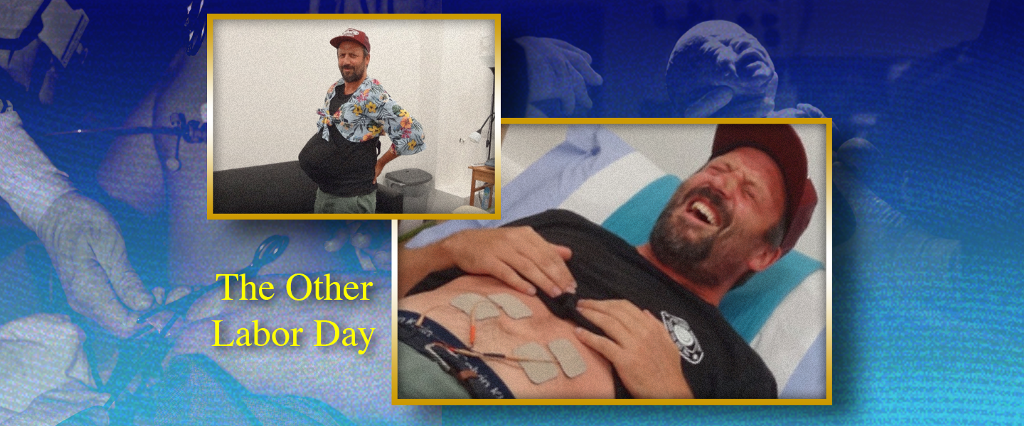Like many before me, as a father I’ve endured various assorted pains: Seemingly endless interrupted sleeps; being puked on and shat on; chronic back pain from the relentless bent-over ushering of doddering toddlers around busy play parks; watching the insufferable Peppa Pig make Daddy Pig’s life hell over and over; and, of course, being kicked, punched, elbowed, kneed and headbutted in the nether regions far too frequently for it to be healthy (there is no age at which your child’s head isn’t perfectly at groin height, which is simultaneously impossible and completely true). But despite all those pains, I’ll never know what’s it’s really like to give birth.
It might be 2018, but science fiction isn’t here yet. Oddly-named megalomaniacs can’t breed humans to use as batteries via kidnapped researchers and covert science, which means that every person born on this planet still experiences a nine-month(ish) gestation period of comfort and bliss, before being dramatically unloaded into an uncompromising reality.
This process occurs an average of 250 times per minute — or 360,000 per day — around the world. While every single birth is different, they all have one key thing in common: Each one is, of course, undertaken by a woman. And no matter the proximity and variety of the support group, no matter how tightly that well-meaning dad squeezes their hand, they always go through the final physical ordeal alone.
As if it even needs to be said, it’s quite the ordeal. “Using one finger of each hand, hook both sides of your mouth and pull as hard as you can,” reckons Cooper C. on NetMums. “Now imagine that feeling down there… that’s the closest thing to pushing I can think of!” Victoria B., again on NetMums, isn’t rose-tinting it either: “I felt like an elephant was trying to escape from my insides and that I was going to die, which of course was a complete overreaction but at the time I was seriously thinking I was being tortured.”
Claire R., meanwhile, reckons it’s “like shitting out a smeg fridge.” Nuff said, really. (For reference, here’s what a smeg fridge looks like.)
Finally, though, there’s at least a way for men to reasonably approximate shitting out said smeg fridge — or allowing said pachyderm to escape from their stomach. And so, here I am at Ultrasound Baby Face in Bristol, U.K., to complete the Labour Pain Experience: A world-first simulation being carried out in a small clinic in a shopping mall. “This is an insight for men into what labor pain feels like,” insists Kate Thomas, the assistant who will be operating the “contraction” machine. “We obviously can’t simulate the exact pain a woman goes through — that would be impossible. But what we can offer is a little insight into the process that might just help you relate to your expectant partner — and maybe even for her to have a little chuckle at the expectant father’s efforts.”
Although a bit late for me — I already have two children — it still sounds like a worthwhile empathy-building exercise, so I gamely prepare myself for the birth. Step one: Donning a feminine blouson and a sort of backwards 10-pound rucksack, which simulates the weight and position of a baby nearing the end of its birthing cycle. Beads of sweat gather on my forehead as I next lean down carefully to pick up scattered wooden toys from the floor, then sit down gingerly on a low chair to paint my toenails. “If your hormonal partner turns you innocently leaving your pants on the floor into World War III, now you know why,” Thomas explains.
In just 15 short minutes, I’m already better appreciating the physiological burden of carrying a child. But now it’s time for labor.

This part involves being hooked up to a machine, basically a pimped-up transcutaneous electrical nerve stimulation machine that will be sending electrical currents through my stomach. The machine has settings for “massage,” “figure-8,” “corner to corner,” “pulse” and “short-sharp” pain. Thomas has a dial to increase the volume, but she assures me it’s simple: As opposed to the average first-time labor length of eight hours, mine is going to last a mere seven minutes.
Since Thomas is a recent mother herself who has also endured the machine, naturally I want to know how closely it replicates the ordeal of labor itself. “If you were getting the short-sharp pain through both the front of your stomach and your back, that could be quite a similar thing,” she says. “But the intensity of the pains and the anticipation of the next one is what makes labor so incredibly difficult. Plus, you must remember: All of a woman’s labor pains are felt internally, not manipulated from outside.”
In other words: Bless you for asking, but no, this will absolutely not give you the right to tell your wife that you went through the same thing.

Super-sharp, insufferable pains bolt through my stomach as I wince, grimace, kick my legs and try to make light of my low-pain threshold between “contractions.” Not knowing what kind of pain is coming, when, and at what ferocity, is an incredibly unpleasant feeling — extreme anxiety welded to acute discomfort. And still: Nothing close to the real thing in terms of the overall experience. “Don’t forget, in amongst all this mental torture and physical agony, you must find time to push,” Thomas reminds me.
I can’t even find time to adjust my cap: Its peak edges down my face as I involuntarily push the back of my head into the pillow and jerk to the sharper spasms. I know I’m being filmed for this story, but despite trying to be macho for the camera and laugh off the pain, it’s not working. As the power is increased, I’m letting out more embarrassing noises and beginning to hanker for the finish line. It’s only been five minutes! (“You let out the kind of noises that most men do,” Thomas assures me afterwards. “It’s meant to be realistic — like giving birth.”)

Minutes later, Thomas stops sending mad electric pulses through me and jokingly presents me with my child: A pre-dressed plastic baby with a creepy visage. I adjust my cap and gesture to the camera to stop. I’ve had some semi-bad injuries in my life, many of which have taken some cleaning and healing, but this sort of pain is altogether on another level. “For every woman, it’s different,” says Thomas. “But for most, it’s usually the most painful physical experience of their lives.”
Once I’m off the machine and have had a moment to reflect, I realize, once again, the enormity of what my partner had to go through — twice. “Every participant so far has admitted an increased empathy for their partner when they’re finished,” Thomas adds. The process, in other words, seems to be working. It’s really such a short, simple experience, but the potential to bond couples more closely, especially before a birth, is huge. In fact, after I leave, I immediately text my partner the video. Her response: “Fair play ”
Maybe she doesn’t believe I really went through anything too terrible. But at least she knows I tried.

